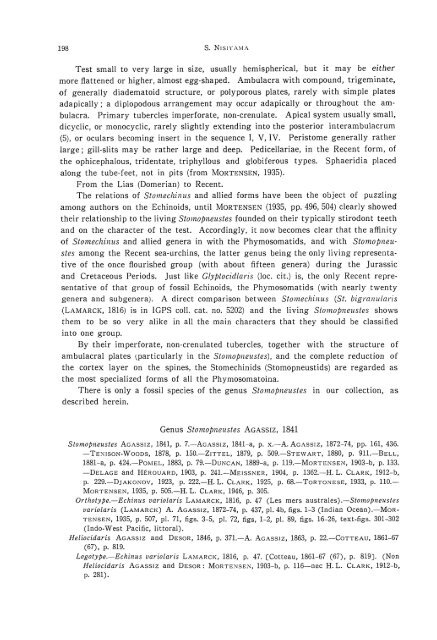the echinoid fauna from japan and adjacent regions part i
the echinoid fauna from japan and adjacent regions part i
the echinoid fauna from japan and adjacent regions part i
Create successful ePaper yourself
Turn your PDF publications into a flip-book with our unique Google optimized e-Paper software.
198<br />
Test small to very large in size, usually hemispherical, but it may be ei<strong>the</strong>r<br />
more flattened or higher, almost egg·shaped. Ambulacra with compound, trigeminate,<br />
of generally diadematoid structure, or polyporous plates, rarely with simple plates<br />
adapically; a diplopodous arrangement may occur adapically or throughout <strong>the</strong> am·<br />
bulacra. Primary tubercles imperforate, non·crenulate. Apical system usually small,<br />
dicyclic, or monocyclic, rarely slightly extending into <strong>the</strong> posterior interambulacrum<br />
(5), or oculars becoming insert in <strong>the</strong> sequence I, V, IV. Peristome generally ra<strong>the</strong>r<br />
large; gill·slits may be ra<strong>the</strong>r large <strong>and</strong> deep. Pedicellariae, in <strong>the</strong> Recent form, of<br />
<strong>the</strong> ophicephalous, tridentate, triphyllous <strong>and</strong> globiferous types. Sphaeridia placed<br />
along <strong>the</strong> tube· feet, not in pits (<strong>from</strong> MORTENSEN, 1935).<br />
From <strong>the</strong> Lias (Domerian) to Recent.<br />
The relations of Stomechinus <strong>and</strong> allied forms have been <strong>the</strong> object of puzzling<br />
among authors on <strong>the</strong> Echinoids, until MORTENSEN (1935, pp. 496, 504) clearly showed<br />
<strong>the</strong>ir relationship to <strong>the</strong> living Stomopneustes founded on <strong>the</strong>ir typically stirodont teeth<br />
<strong>and</strong> on <strong>the</strong> character of <strong>the</strong> test. Accordingly, it now becomes clear that <strong>the</strong> affinity<br />
of Stomechinus <strong>and</strong> allied genera in with <strong>the</strong> Phymosomatids, <strong>and</strong> with Stomo pneu·<br />
stes among <strong>the</strong> Recent sea·urchins, <strong>the</strong> latter genus being <strong>the</strong> only living representa·<br />
tive of <strong>the</strong> once flourished group (with about fifteen genera) during <strong>the</strong> Jurassic<br />
<strong>and</strong> Cretaceous Periods. Just like Glyptocidlaris (ioc. cit.) is, <strong>the</strong> only Recent repre·<br />
sentative of that group of fossil Echinoids, <strong>the</strong> Phymosomatids (with nearly twenty<br />
genera <strong>and</strong> subgenera). A direct comparison between Stomechinus (St. bigranlllaris<br />
(LAMARCK, 1816) is in IGPS colI. cat. no. 5202) <strong>and</strong> <strong>the</strong> living Stomopneustes shows<br />
<strong>the</strong>m to be so very alike in all <strong>the</strong> main characters that <strong>the</strong>y should be classified<br />
into one group.<br />
By <strong>the</strong>ir imperforate, non·crenulated tubercles, toge<strong>the</strong>r with <strong>the</strong> structure of<br />
ambulacral plates ,<strong>part</strong>icularly in <strong>the</strong> Stomopnellstes), <strong>and</strong> <strong>the</strong> complete reduction of<br />
<strong>the</strong> cortex layer on <strong>the</strong> spines, <strong>the</strong> Stomechinids (Stomopneustids) are regarded as<br />
<strong>the</strong> most specialized forms of all <strong>the</strong> Phymosomatoina.<br />
There is only a fossil species of <strong>the</strong> genus Stomopnellstes in our collection, as<br />
described herein.<br />
Genus Stomopneustes AGASSIZ, 1841<br />
Stomopneustes AGASSIZ, 1841, p. 7.-AGASSIZ, 184l-a, p. x.-A. AGASSIZ, 1872-74, pp. 161, 436.<br />
-TE;\;ISON·WOODS, 1878, p. 150.-ZITTEL, 1879, p. 509.-STEWART, 1880, p. 91l.-BELL,<br />
1881-a, p. 424.-POMEL, 1883, p. 79.-DuNCAN, 1889-a, p. 119.-MoRTENSEN, 1903-b, p.133.<br />
-DELAGE <strong>and</strong> HEROUARD, 1903, p. 24l.-MEISSNER, 1904, p. 1362.-H. L. CLARK, 1912-b,<br />
p. 229.-DJAKOP;OV, 1923, p. 222.-H. L. CLARK, 1925, p. 68.-TORTONESE, 1933, p. 1l0.<br />
MORTENSEN, 1935, p. 505.-H. L. CLARK, 1946, p. 305.<br />
Orthotype.-Echinus variolaris LAMARCK, 1816, p. 47 (Les mers australes).-Stomopneustes<br />
variolaris (LAMARCK) A. AGASSIZ, 1872-74, p. 437, pI. 4b, figs. 1-3 (Indian Ocean).-MoR.<br />
TENSEN, 1935, p. 507, pI. 71, figs. 3-5, pI. 72, figs, 1-2, pI. 89, figs. 16-26, text·figs. 301-302<br />
(Indo·West Pacific, littoral).<br />
Heliocidaris AGASSIZ <strong>and</strong> DESOR, 1846, p. 371.-A. AGASSIZ, 1863, p. 22.-COTTEAU, 1861-67<br />
(67), p. 819.<br />
Logotype.-Echinus variolaris LAMARCK, 1816, p. 47. [Cotteau, 1861-67 (67), p. 819J. (Non<br />
Heliocidaris AGASSIZ <strong>and</strong> DESOR: MORTENSE;\;, 1903-b, p. 116-nec H. L. CLARK, 1912-b,<br />
p. 281).












